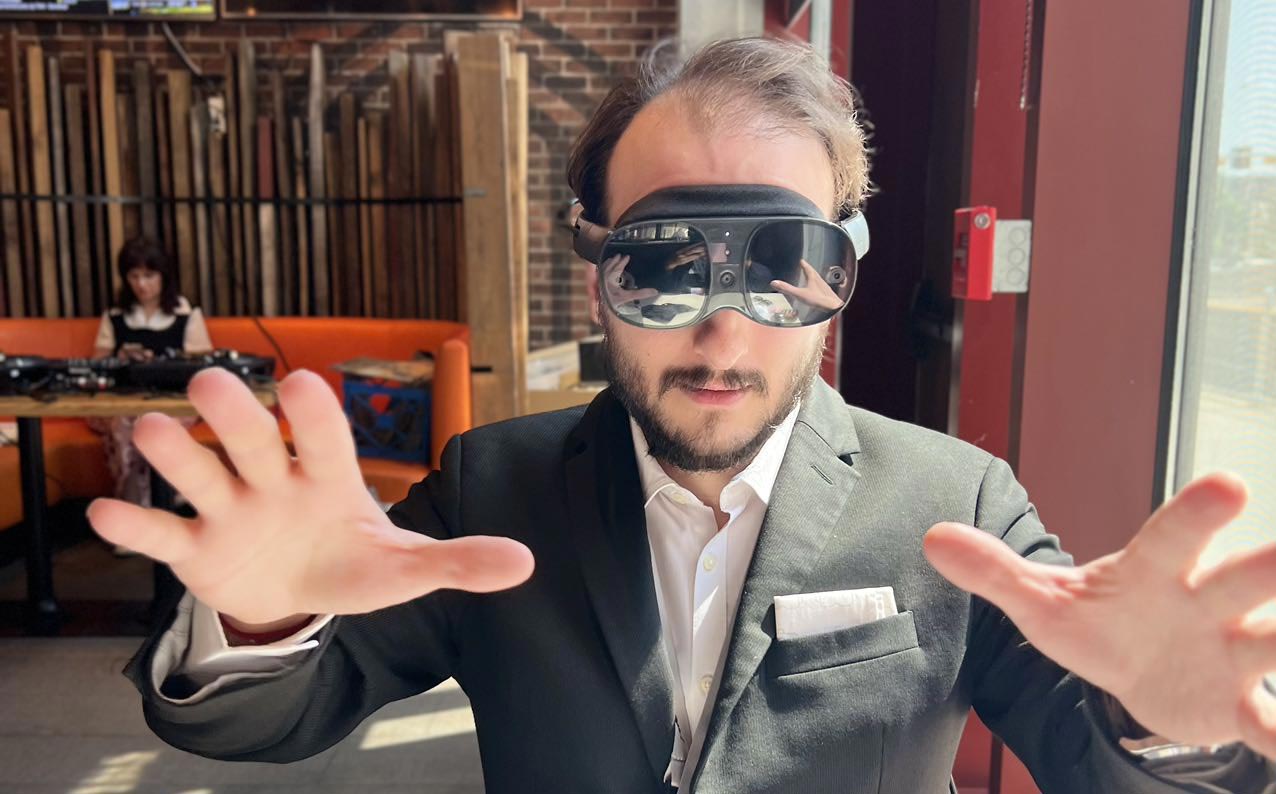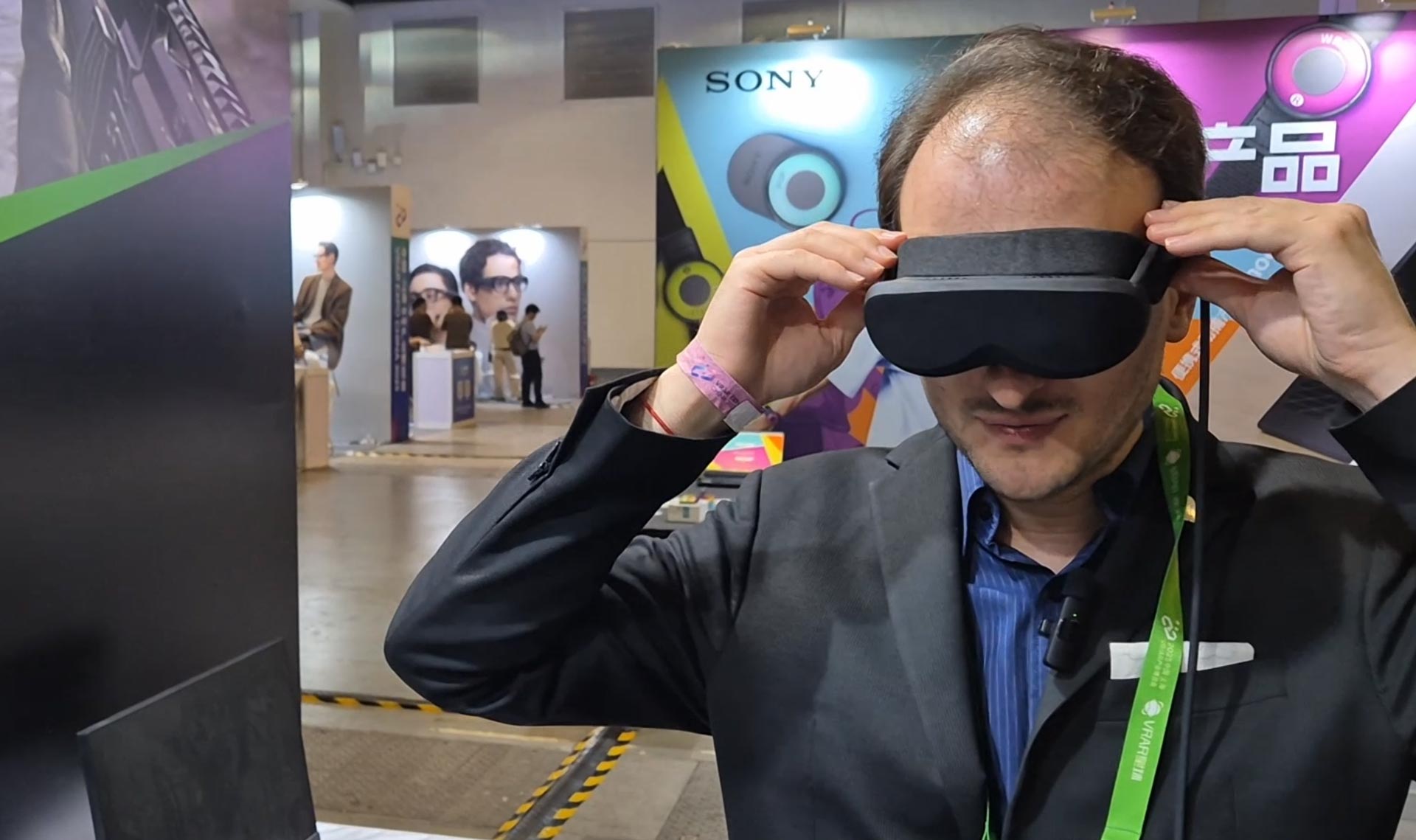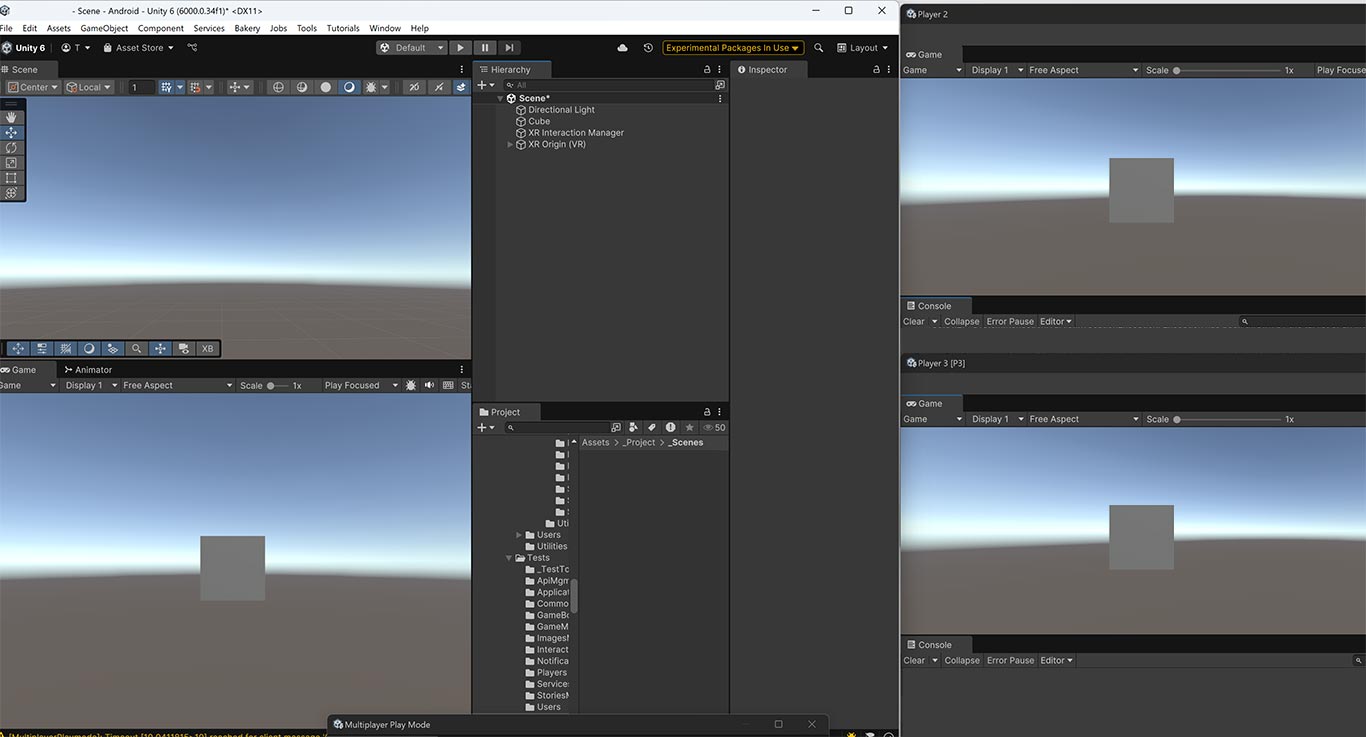Short hands-on at SXSW: Vive XR Elite, HYPERVSN… the CIA… and more!
Today I want to tell you about some very short hands-on sessions I had during my attendance at the SXSW festival. They were all very interesting experiences, but given the very short time I had with these devices, what I’m going to write can’t be considered a real review, but more some kind of first impression.
Vive XR Elite
Finally, I’ve been able to put a Vive XR Elite on my head. Thanks to the kindness of “Mister President” Alvin Wang Graylin, I’ve been finally able to put this headset on my hand for a few minutes. It wasn’t a proper demo: I just put his personal device on my head while I was in a restaurant. Then the waiter arrived and said “your tacos have arrived, return back to the real world” and I had to stop my short session.
Comfort and design

I have to say that in the few minutes I had with the device, I was pleasantly surprised by it. The headset is for sure small and lightweight, and also design-wise, it’s something with which is possible to have cool photos. Let’s say we are not at sunglasses levels, but for sure we are at a point where XR devices start to become nice to have on the face.
The headset was comfortable and felt quite stable on my head, even when rotating it. I maybe would have preferred to have the additional strap that puts the weight on top of the head so that to feel the weight even better distributed, but that’s a personal taste.
Detachable feature
The Vive XR Elite can work in full standalone mode, or you can detach the battery and connect it to an external power source. I’ve tried to remove the back battery and use the headset as if it was a pair of “big sunglasses”. The operation was super easy and fast: for every one of the two frames, I had just to press a button, then remove the back part with the battery, and insert two clips that made the frames longer. I didn’t imagine this to be so easy.

I had the paranoia to make the glasses turn off during this operation, but Mister President told me that the XR Elite has a small internal battery that makes the headset survive around 10-15 minutes without an attached power source. This is great for usability.
When I tried the device without the usual “crown”, but just with the frames that kept it on my head, I didn’t like much the fit. The frames were a bit big and I clearly felt them touching my ears, plus they had to clench my head to keep the glasses in place and this was not very comfortable. Plus when I tried to move my head a bit faster, I noticed that they didn’t feel as stable as before. I think this mode is nice, but probably useful only if you are lying on a bed to watch some VR media. When playing VR games, I would use the standard standalone mode with the battery on the back.
UI, UX, and Visuals
When I wore the headset, I could appreciate that the quality of the images was quite high, and there was almost no screen door effect. I really had to concentrate to perceive a kind of “grid noise” of the pixels. The only problem with the visuals is that the colors seemed a bit washed out to me (but I’m not sure if the device was set to have low brightness).
The UI of the runtime looked identical to the one of the Vive Flow. I could interact with everything just using my hands, and hand tracking was pretty stable and reliable, even if I was close to a window on a sunny day. The only problem was that hand tracking couldn’t track the hands when they were one on top of the other.
General impressions
The Vive XR Elite overall seemed to me an interesting headset. I need to spend proper time with it to give a final opinion, but the first impression was surely good. And also the tacos were not bad, in the end.
HYPERVSN
HYPERVSN is a company that produces systems that show “holograms” (improper term, I know) that can be seen without any kind of glasses. I heard some colleagues of mine talking about it after CES, so I was happy to be able to visit its booth at SXSW. And I came out of it with mixed feelings.
First of all, I was surprised to discover how the HYPERVSN technology was working. I thought they were using Pepper Ghost or similar technologies based on mirrors and reflection, but I couldn’t be more wrong. Its hologram screens work by using arrays of rotating hologram fans.

I guess you’ve already seen hologram fans: they are fans whose arms emit light so that when rotated very fast, they can show an image that appears in the air. HYPERVSN uses a grid of these fans to build screens of whatever size: by putting the fans in a grid so that they are all next to each other, using the fans just to show a little part of the image, and coordinating the images shown on every fan, it is possible to show a global big image on the grid. This is how they can build very big holograms.
At SXSW various different displays were shown: some were just of the dimension of a single person, others were more like a big TV, and one, that was clearly there to attract a crowd, was a huge one, probably tall 4m or something like that. It was impressive. I appreciated a lot the versatility of the HYPERVSN system.

I have to say that when the illusion of the 3D hologram worked, it was really cool. I remember one of the displays, the one having the size of a big wall TV, was showing a car configurator. And the car there looked truly three-dimensional, like it was really there. I was completely stoked by it and impressed that everyone in the room could see that without wearing glasses.
But other screens were less exciting: the human hostess shown on a dedicated hologram screen looked kinda flat, for instance. Also, the big display didn’t have a great depth effect, even if some of the images shown were still impressive.
I think that in the end the quality of the “3D effect” is determined by how the source was recorded, plus the point of view from where you are looking at the “hologram”. Since these screens don’t track your head, I guess that like in The Looking Glass, you have the perception of the depth of the holograms only from specific points of view. This means that depending on the content showcased and where you are in the room, the sense of realism you are perceiving may vary a lot.

Another issue I noticed was the “tearing”, especially on the giant screen. A slight timing mismatch between how the images are shown on every fan, especially for objects moving quite fast can create a glitching effect resulting in tearings of the global image. The effect is noticeable to a technical eye. Also, sometimes I could spot the black dots of the centers of the fans cluttering the big global hologram.
A last issue is that since the images are holograms, they are also slightly transparent, so don’t appear fully opaque.
My final impression of HYPERVSN holograms is that they are very interesting for specific use cases, like having a wow effect at your booth that can attract some curious crowd. But honestly, I don’t see this becoming “THE hologram” technology, because its current tech has some limitations. So: nice, but not perfect.
Titan Haptics
I happily stopped at the Titan Haptics booth to visit the lovely Ashley Huffman. There I had on my hand for the first time the pure component of a haptic motor. It is interesting how such a small gadget can give such cool effects to our games!

Ashely told me that Titan makes haptic motors for different kinds of applications: not only for entertainment but also for other sectors, like automotive. Of course, the motors used for the seat of your car are bigger than the ones in your VR controller.
At the Titan booth, I had one interesting small demo. I could see the reproduction (a Twitch-like view) of an FPS game played on a tablet. I could hold the small haptic motor in my hand, and it was replicating vibrations for everything that was happening on the screen: a bullet shot, the player running, the player hurt, and so on. The game felt quite alive. Then the steward at the booth removed the haptic feedback, and the video alone immediately felt boring and useless. It was a simple and effective demo of how haptic can contribute to immersion in a game. It is something that I think has still to be universally understood by the VR community… but PSVR 2 is helping a lot in this sense.
Dentsu’s Phantom Snack

Dentsu was showcasing some crazy and innovative experiments at its booth. There was a mannequin that you could hug with a special haptic suit that changed color depending on what you felt. And then there were the “phantom snacks”. Since I am a ghost, I had absolutely to try the Phantom Snacks!
The Phantom Snacks were a machine aimed at simulating that you were eating something. The idea was that you could select on the screen what you wanted to eat and then the machine would make you virtually eat that food. The illusion was provided via scent emission for the taste and stimulation of the muscles of my jaw to fake the stiffness of the food.
I tried to eat both chocolate cookies and a salad, but while I loved the concept, I didn’t find the illusion of eating working very well. The scents felt very artificial, and the muscle stimulation wasn’t working well with me: the device did not detect every time I was performing the chewing movement, plus the stimulation felt a bit surreal, too. Again, great idea, and I love who is trying to emulate smell and taste in VR, but there is still a lot of work to do.
CIA Glasses
I was wandering around the SXSW Expo when I saw the booth of the CIA. I thought was something with a similar name to the secret service, but then no, I realized it was actually the Central Intelligence Agency. Oh wow.

I was looking around when a very kind woman approached me, asking if I wanted some info. I wanted to ask her if there was any secret way the CIA could use to delete from the databases of the internet providers my history of the porn I regret watching, but then I decided to keep a low profile. I instead asked how things were going, and she answered that her SXSW was going great. She had a kind attitude and a soothing voice but she gave me the impression that underneath she could also kill me by just using the pinky finger of her left hand. In 37 different ways.
I saw a VR headset in the booth and I asked what kind of VR experience they were offering, and she told me it was a virtual tour of the CIA offices. I said her it was a bit lame and was looking for something more interesting, because I’m a VR professional, so I’m looking for more high-level experiences. I guess she already knew I was a VR professional, probably because the CIA smart contact lenses in her eyes already told her everything about me. Included all the links of the internet history I wanted to delete. Damn.
She told me that the XR training experiences that the CIA uses are of course not of the public domain and can’t be showcased. I did not insist on asking her more, because I didn’t want to discover one of the 37 magic moves of her pinky finger. I wondered if she learned those 37 moves in VR… but I avoided asking.
I kindly thanked her for her time and kindness, and then I asked if I could take home some goodies from the booth. I so took two gadgets:
- A camera cover for my laptop. I guess that if I use it, its function is to cover my camera for everyone with the exception of the CIA
- A pair of plastic sunglasses, with the CIA brand. We all complain about the data that Meta may steal from its headsets, but I’m pretty sure these fake sunglasses are truly next-level and have inside some sensors that take everything I do and see and send it directly to the CIA. I wore them for my last two days in Austin, and sometimes I asked the people in front of me to say hello to the secret agents that could have watched us. Good manners are always important, you know.

If you don’t read a new article of mine in the next 7 days, you know that I messed up by writing this stupid paragraph about the CIA. It has been a pleasure to be part of the VR community with you, please remember me with a smile 🙂
And that’s it! I still have a few stories about SXSW I have to tell you, but I’ll do that in the next weeks. In the meanwhile, enjoy your Sunday and subscribe to my newsletter to not miss my next article!
Disclaimer: this blog contains advertisement and affiliate links to sustain itself. If you click on an affiliate link, I'll be very happy because I'll earn a small commission on your purchase. You can find my boring full disclosure here.




